Abstract
Because the range of bowel habits and stool types in the community is unknown we questioned 838 men and 1059 women, comprising 72.2% of a random stratified sample of the East Bristol population. Most of them kept records of three consecutive defecations, including stool form on a validated six point scale ranging from hard, round lumps to mushy. Questionnaire responses agreed moderately well with recorded data. Although the most common bowel habit was once daily this was a minority practice in both sexes; a regular 24 hour cycle was apparent in only 40% of men and 33% of women. Another 7% of men and 4% of women seemed to have a regular twice or thrice daily bowel habit. Thus most people had irregular bowels. A third of women defecated less often than daily and 1% once a week or less. Stools at the constipated end of the scale were passed more often by women than men. In women of child bearing age bowel habit and the spectrum of stool types were shifted towards constipation and irregularity compared with older women and three cases of severe slow transit constipation were discovered in young women. Otherwise age had little effect on bowel habit or stool type. Normal stool types, defined as those least likely to evoke symptoms, accounted for only 56% of all stools in women and 61% in men. Most defecations occurred in the early morning and earlier in men than in women. We conclude that conventionally normal bowel function is enjoyed by less than half the population and that, in this aspect of human physiology, younger women are especially disadvantaged.
Full text
PDF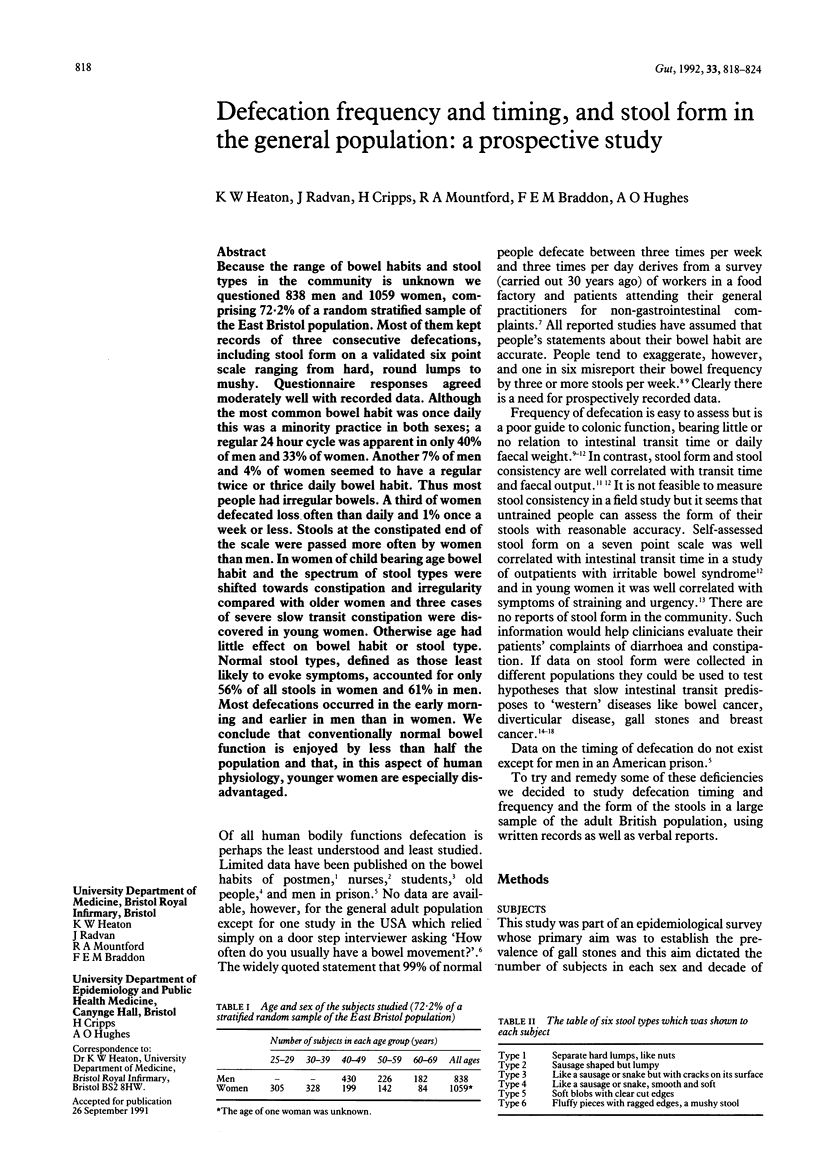
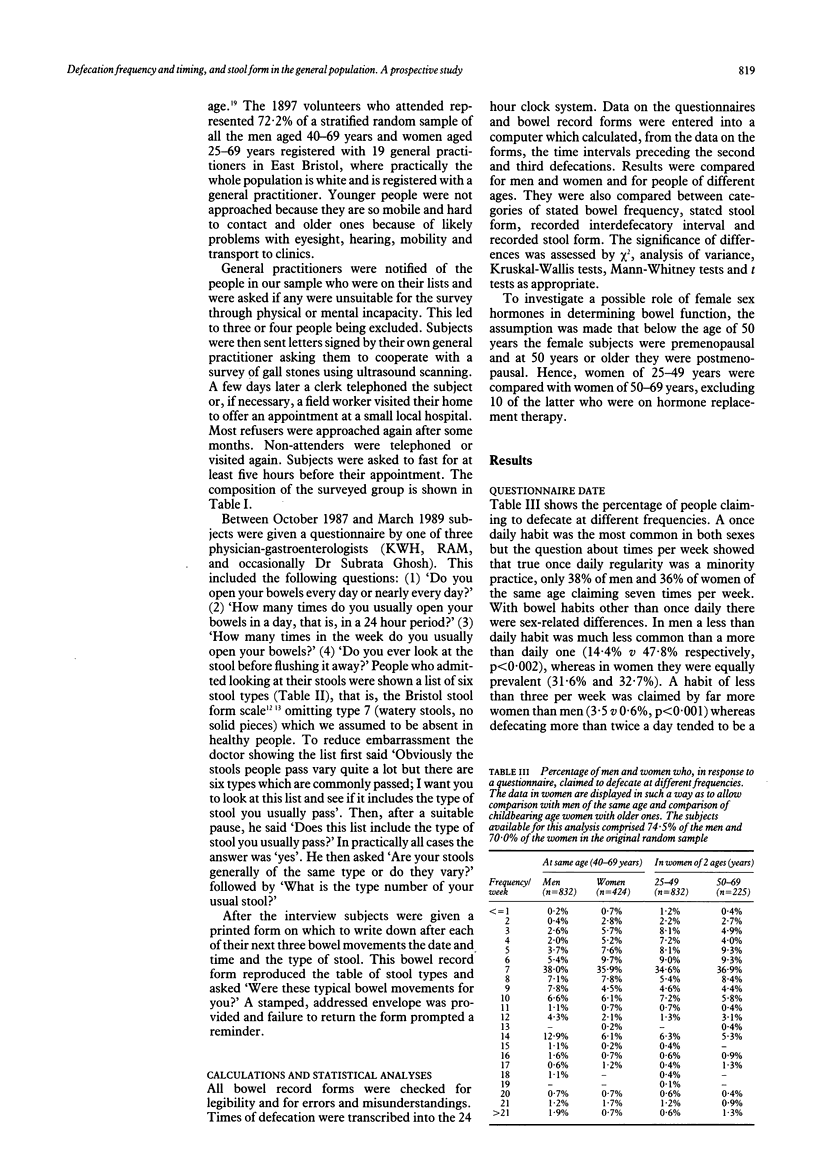

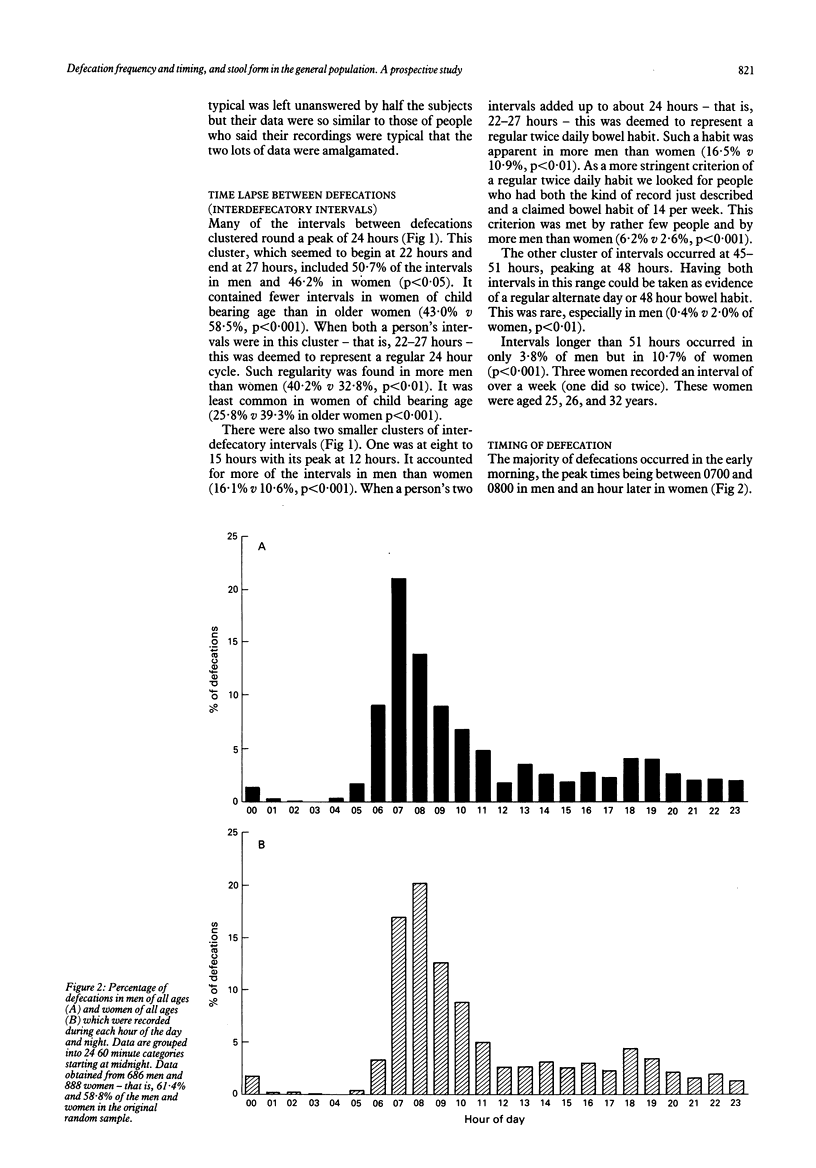
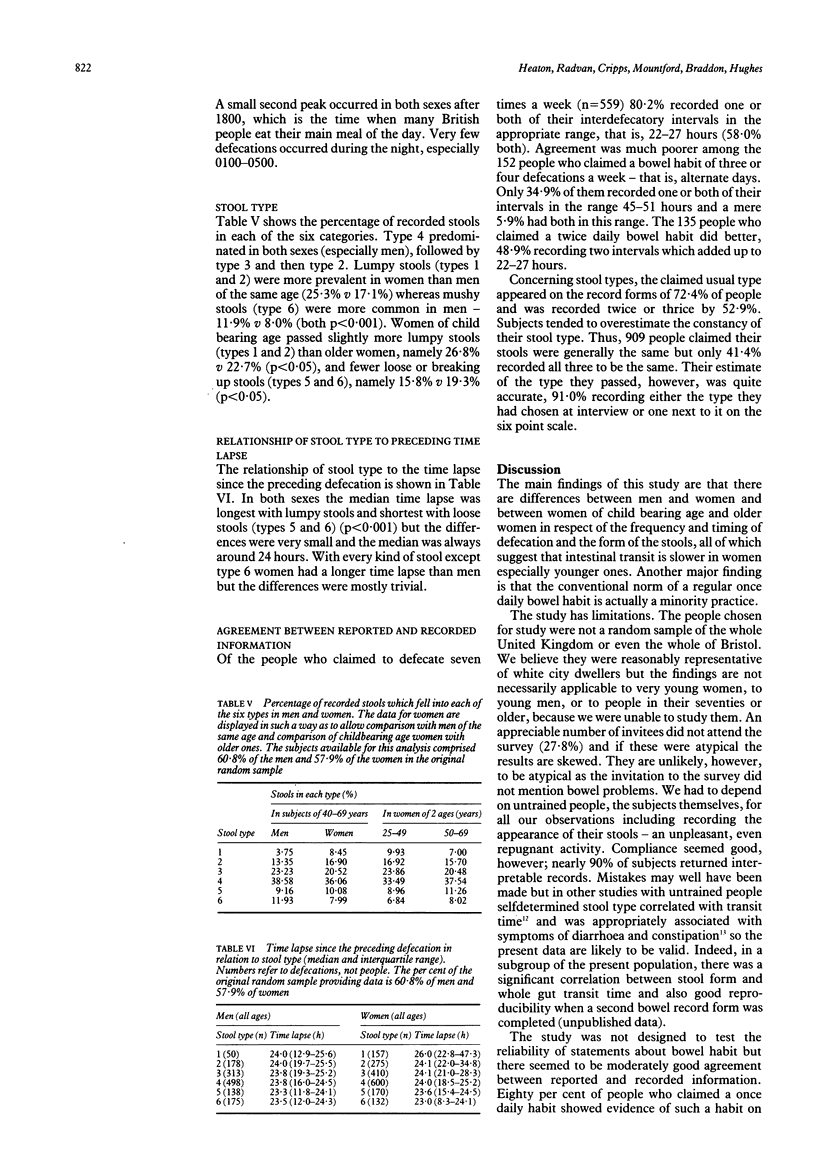
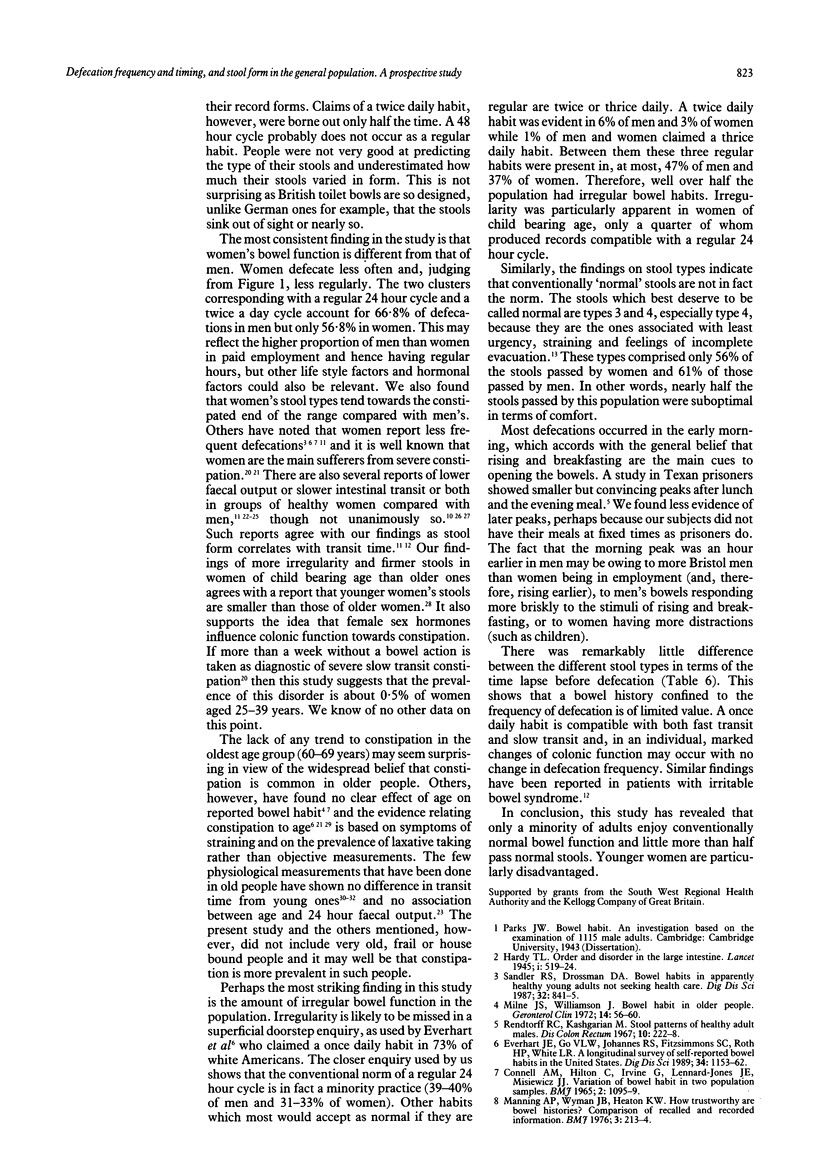
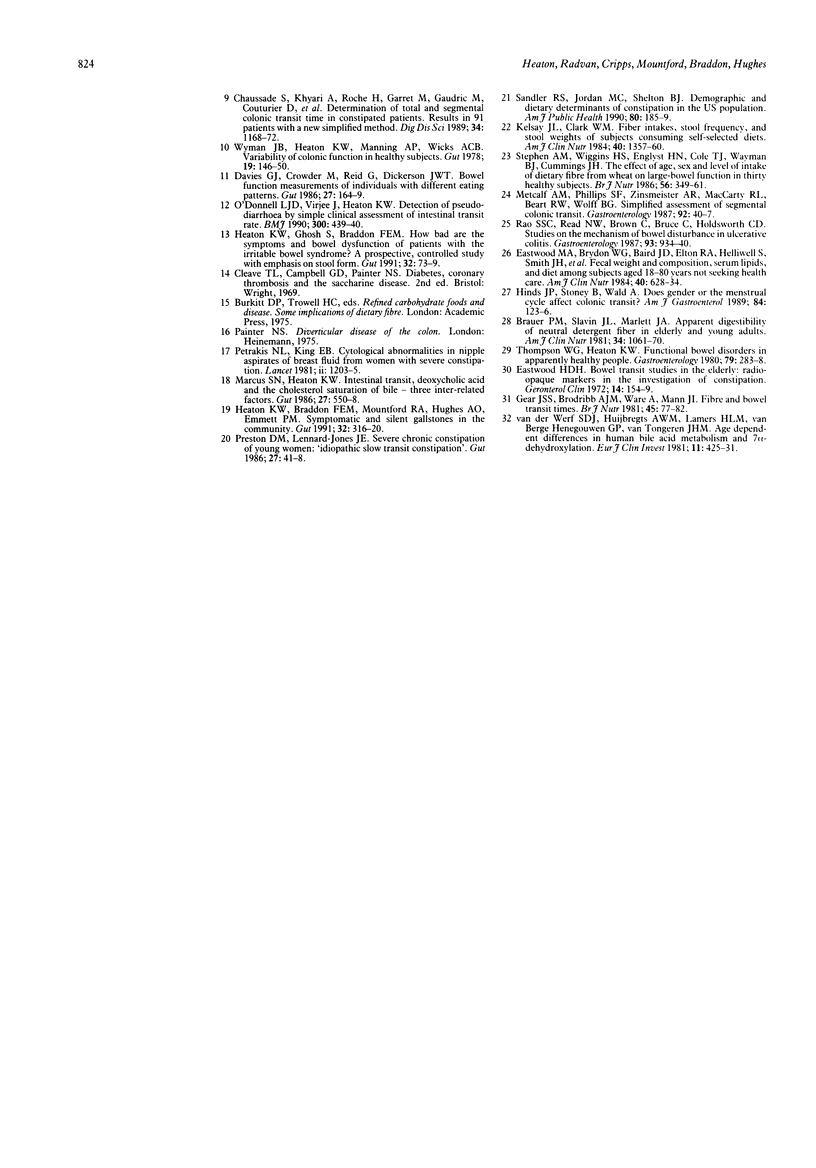
Selected References
These references are in PubMed. This may not be the complete list of references from this article.
- Brauer P. M., Slavin J. L., Marlett J. A. Apparent digestibility of neutral detergent fiber in elderly and young adults. Am J Clin Nutr. 1981 Jun;34(6):1061–1070. doi: 10.1093/ajcn/34.6.1061. [DOI] [PubMed] [Google Scholar]
- Chaussade S., Khyari A., Roche H., Garret M., Gaudric M., Couturier D., Guerre J. Determination of total and segmental colonic transit time in constipated patients. Results in 91 patients with a new simplified method. Dig Dis Sci. 1989 Aug;34(8):1168–1172. doi: 10.1007/BF01537263. [DOI] [PubMed] [Google Scholar]
- Connell A. M., Hilton C., Irvine G., Lennard-Jones J. E., Misiewicz J. J. Variation of bowel habit in two population samples. Br Med J. 1965 Nov 6;2(5470):1095–1099. doi: 10.1136/bmj.2.5470.1095. [DOI] [PMC free article] [PubMed] [Google Scholar]
- Davies G. J., Crowder M., Reid B., Dickerson J. W. Bowel function measurements of individuals with different eating patterns. Gut. 1986 Feb;27(2):164–169. doi: 10.1136/gut.27.2.164. [DOI] [PMC free article] [PubMed] [Google Scholar]
- Eastwood H. D. Bowel transit studies in the elderly: radio-opaque markers in the investigation of constipation. Gerontol Clin (Basel) 1972;14(3):154–159. doi: 10.1159/000245387. [DOI] [PubMed] [Google Scholar]
- Eastwood M. A., Brydon W. G., Baird J. D., Elton R. A., Helliwell S., Smith J. H., Pritchard J. L. Fecal weight and composition, serum lipids, and diet among subjects aged 18 to 80 years not seeking health care. Am J Clin Nutr. 1984 Sep;40(3):628–634. doi: 10.1093/ajcn/40.3.628. [DOI] [PubMed] [Google Scholar]
- Gear J. S., Brodribb A. J., Ware A., Mann J. I. Fibre and bowel transit times. Br J Nutr. 1981 Jan;45(1):77–82. doi: 10.1079/bjn19810078. [DOI] [PubMed] [Google Scholar]
- Heaton K. W., Braddon F. E., Mountford R. A., Hughes A. O., Emmett P. M. Symptomatic and silent gall stones in the community. Gut. 1991 Mar;32(3):316–320. doi: 10.1136/gut.32.3.316. [DOI] [PMC free article] [PubMed] [Google Scholar]
- Heaton K. W., Ghosh S., Braddon F. E. How bad are the symptoms and bowel dysfunction of patients with the irritable bowel syndrome? A prospective, controlled study with emphasis on stool form. Gut. 1991 Jan;32(1):73–79. doi: 10.1136/gut.32.1.73. [DOI] [PMC free article] [PubMed] [Google Scholar]
- Hinds J. P., Stoney B., Wald A. Does gender or the menstrual cycle affect colonic transit? Am J Gastroenterol. 1989 Feb;84(2):123–126. [PubMed] [Google Scholar]
- Kelsay J. L., Clark W. M. Fiber intakes, stool frequency, and stool weights of subjects consuming self-selected diets. Am J Clin Nutr. 1984 Dec;40(6 Suppl):1357–1360. doi: 10.1093/ajcn/40.6.1357. [DOI] [PubMed] [Google Scholar]
- Manning A. P., Wyman J. B., Heaton K. W. How trustworthy are bowel histories? Comparison of recalled and recorded information. Br Med J. 1976 Jul 24;2(6029):213–214. doi: 10.1136/bmj.2.6029.213. [DOI] [PMC free article] [PubMed] [Google Scholar]
- Marcus S. N., Heaton K. W. Intestinal transit, deoxycholic acid and the cholesterol saturation of bile--three inter-related factors. Gut. 1986 May;27(5):550–558. doi: 10.1136/gut.27.5.550. [DOI] [PMC free article] [PubMed] [Google Scholar]
- Metcalf A. M., Phillips S. F., Zinsmeister A. R., MacCarty R. L., Beart R. W., Wolff B. G. Simplified assessment of segmental colonic transit. Gastroenterology. 1987 Jan;92(1):40–47. doi: 10.1016/0016-5085(87)90837-7. [DOI] [PubMed] [Google Scholar]
- Milne J. S., Williamson J. Bowel habit in older people. Gerontol Clin (Basel) 1972;14(1):56–60. doi: 10.1159/000245372. [DOI] [PubMed] [Google Scholar]
- O'Donnell L. J., Virjee J., Heaton K. W. Detection of pseudodiarrhoea by simple clinical assessment of intestinal transit rate. BMJ. 1990 Feb 17;300(6722):439–440. doi: 10.1136/bmj.300.6722.439. [DOI] [PMC free article] [PubMed] [Google Scholar]
- Petrakis N. L., King E. B. Cytological abnormalities in nipple aspirates of breast fluid from women with severe constipation. Lancet. 1981 Nov 28;2(8257):1203–1204. doi: 10.1016/s0140-6736(81)91441-0. [DOI] [PubMed] [Google Scholar]
- Preston D. M., Lennard-Jones J. E. Severe chronic constipation of young women: 'idiopathic slow transit constipation'. Gut. 1986 Jan;27(1):41–48. doi: 10.1136/gut.27.1.41. [DOI] [PMC free article] [PubMed] [Google Scholar]
- Rao S. S., Read N. W., Brown C., Bruce C., Holdsworth C. D. Studies on the mechanism of bowel disturbance in ulcerative colitis. Gastroenterology. 1987 Nov;93(5):934–940. doi: 10.1016/0016-5085(87)90554-3. [DOI] [PubMed] [Google Scholar]
- Rendtorff R. C., Kashgarian M. Stool patterns of healthy adult males. Dis Colon Rectum. 1967 May-Jun;10(3):222–228. doi: 10.1007/BF02617184. [DOI] [PubMed] [Google Scholar]
- Sandler R. S., Drossman D. A. Bowel habits in young adults not seeking health care. Dig Dis Sci. 1987 Aug;32(8):841–845. doi: 10.1007/BF01296706. [DOI] [PubMed] [Google Scholar]
- Sandler R. S., Jordan M. C., Shelton B. J. Demographic and dietary determinants of constipation in the US population. Am J Public Health. 1990 Feb;80(2):185–189. doi: 10.2105/ajph.80.2.185. [DOI] [PMC free article] [PubMed] [Google Scholar]
- Stephen A. M., Wiggins H. S., Englyst H. N., Cole T. J., Wayman B. J., Cummings J. H. The effect of age, sex and level of intake of dietary fibre from wheat on large-bowel function in thirty healthy subjects. Br J Nutr. 1986 Sep;56(2):349–361. doi: 10.1079/bjn19860116. [DOI] [PubMed] [Google Scholar]
- Thompson W. G., Heaton K. W. Functional bowel disorders in apparently healthy people. Gastroenterology. 1980 Aug;79(2):283–288. [PubMed] [Google Scholar]
- Wyman J. B., Heaton K. W., Manning A. P., Wicks A. C. Variability of colonic function in healthy subjects. Gut. 1978 Feb;19(2):146–150. doi: 10.1136/gut.19.2.146. [DOI] [PMC free article] [PubMed] [Google Scholar]
- van der Werf S. D., Huijbregts A. W., Lamers H. L., van Berge Henegouwen G. P., van Tongeren J. H. Age dependent differences in human bile acid metabolism and 7 alpha-dehydroxylation. Eur J Clin Invest. 1981 Dec;11(6):425–431. doi: 10.1111/j.1365-2362.1981.tb02009.x. [DOI] [PubMed] [Google Scholar]


